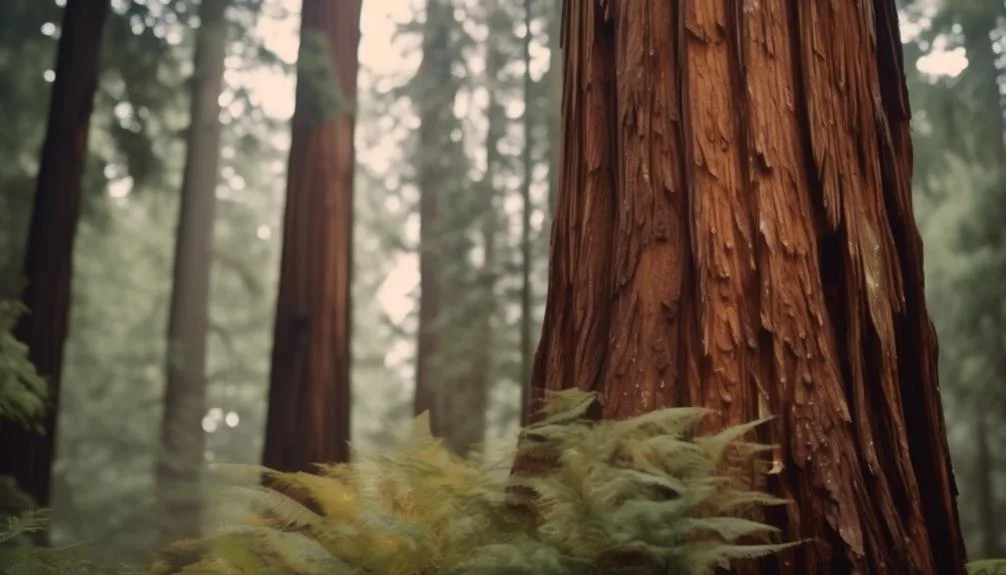Caring for your redwood trees is a rewarding challenge, but dealing with common diseases can be tough. You're not alone. With the right knowledge, you can fight these diseases and restore your trees.
Where do you start? First, let's figure out what these diseases are and how to prevent them from harming your redwoods.
Identifying Redwood Tree Diseases
To identify redwood tree diseases, start by closely inspecting the foliage and trunk for any signs of discoloration, lesions, or unusual growths. Early detection is crucial in preventing the spread of diseases. Keep an eye out for any changes in the color or texture of the leaves, as well as any abnormal swellings or areas of dead tissue on the trunk.
Additionally, consider the disease resistance of different redwood varieties when selecting new trees for planting. Some varieties may be more resistant to certain diseases, which can help prevent future issues.
Preventative Measures for Redwood Tree Diseases
Considering the climate and soil conditions in your area, implementing preventative measures can effectively protect your redwood trees from diseases. To ensure the health of your redwood trees, here are some essential preventative measures to consider:
- Regular Pruning: Proper pruning techniques can help maintain the structural integrity of your redwood trees, allowing for better air circulation and light penetration, which can prevent the development of certain diseases.
- Soil Health: Maintaining optimal soil health is crucial for the overall well-being of your redwood trees. Conduct regular soil tests and amend the soil as needed to ensure that it provides the necessary nutrients and drainage for the trees to thrive.
- Monitoring and Maintenance: Regularly inspect your redwood trees for any signs of disease or stress. Promptly address any issues and ensure that the trees receive adequate water and nutrients to maintain their health.
Treating Fungal Infections in Redwood Trees
If your redwood trees are affected by fungal infections, prompt and targeted treatment is essential to restore their health and vitality.
To begin with, focus on fungal spore prevention by removing and destroying infected plant debris around the trees. Prune any affected branches, making clean cuts to prevent further spread.
Consider applying fungicidal treatments, following the product instructions carefully.
Additionally, implementing proper soil aeration techniques can help improve the overall health of the trees and prevent future fungal infections. This includes avoiding waterlogged soil and ensuring proper drainage. Consider incorporating organic matter into the soil to enhance its structure and promote beneficial microbial activity.
Managing Insect Infestations in Redwood Trees
Addressing fungal infections promptly and implementing preventive measures are crucial in helping your redwood trees recover and thrive. Now, let's turn our attention to managing insect infestations in your redwood trees.
- Regular Inspection: Conduct routine inspections to detect insect infestations early and take prompt action.
- Natural Predators: Encourage natural predators like ladybugs and lacewings to help control insect populations.
- Selective Pruning: Remove and destroy infested branches to prevent the spread of insects to other parts of the tree.
Effective insect control is essential for the preservation of your redwood trees. By staying vigilant and implementing these strategies, you can help maintain the health and vitality of your majestic redwood trees.
Addressing Nutrient Deficiencies in Redwood Trees
To ensure the optimal growth and health of your redwood trees, it's essential to address any nutrient deficiencies they may be experiencing. Soil testing is crucial to determine the specific nutrients lacking in the soil. You can conduct soil tests through your local agricultural extension office, which will provide detailed recommendations based on the results.
Once you identify the nutrient deficiencies, you can proceed with targeted fertilizer application. Select a high-quality fertilizer specifically formulated for redwood trees and follow the application instructions carefully. Typically, nitrogen, phosphorus, and potassium are key nutrients for redwood trees. However, it's important to ensure the proper balance of all essential nutrients.
Regular soil testing and appropriate fertilizer application can effectively address nutrient deficiencies, promoting the overall vigor and resilience of your redwood trees.
Conclusion
By proactively identifying and addressing redwood tree diseases,
managing infestations, and ensuring proper nutrients,
your redwood trees can thrive for years to come.
With dedicated care, your redwoods will stand strong and beautiful,
enhancing your landscape for generations.
Mark Hoffman is a dedicated arborist and tree care specialist with over a decade of experience. His love for trees began when he visited Yosemite National Park as a teenager and was awestruck by the giant sequoias. Mark pursued his passion by studying forestry at Michigan Technological University, where he earned a Bachelor of Science degree.
Since then, he has worked tirelessly in the field of arboriculture, helping to preserve and protect trees in his community. His expertise and dedication have made him a respected leader in the industry and a valuable resource for anyone seeking advice on tree care.
